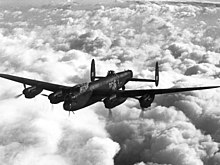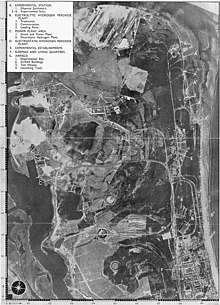Operation Hydra

Operation Hydra was the name of the first bombing of the Peenemünde Army Research Center and the Air Force test site "Peenemünde-West" on Usedom on the night of August 17-18, 1943 by the British Royal Air Force . In preparation, on August 10, 1943 , ten British fighter planes carried out a mock attack in the direction of Berlin ( Operation Whitebait) with flight routes near Peenemünde , in order to conceal the actual target of the German air force - the military facilities in Peenemünde.
bombardment

On August 17, 1943, the moon was full and Arthur Harris , Commander in Chief of the RAF Bomber Command , gave orders to carry out Operation Hydra and Whitebait. The British bomber fleet consisted of 596 aircraft (324 Avro Lancaster , 218 Handley Page Halifax , 54 Short Stirling ); in addition 28 De Havilland DH.98 Mosquitos and 10 Bristol Beaufighters for the deception attack on Berlin. This goal was led by the Bomber Command under the code name "Whitebait" ( Breitling ). Harris' deputy was Air Vice-Marshal Robert Saundby . The enthusiastic fisherman provided all of the German cities that were selected with a "Fish code".
The deception succeeded: when the bombers flew over Denmark and the Baltic Sea towards Berlin at around 11 p.m. , they were expected by around 200 German fighters, around 150 of whom were concentrated in the greater Berlin area.
At 11:09 p.m. the sirens sounded in Peenemünde. At around 01:09 am, the Pathfinder Force set off luminous markings around the Army Research Center, eight minutes later (01:17 am) bombs of the first wave (227 machines) hit the living quarters of the scientists in Karlshagen ; 123 people died, including the scientist Walter Thiel . Wernher von Braun was able to save himself in a bunker.
The first wave was a deliberate attempt to compromise missile projects by eliminating scientists. However, due to a marking error by the boy scouts, a third of the machines bombed the prisoner camps Trassenheide I and Trassenheide II between the localities of Karlshagen and Trassenheide . 612 forced laborers were killed.
The second wave with 113 machines attacked the test series plant with the two large production halls F1 and F2, the third wave with 180 machines attacked the development plant. A total of 1,874 tons of explosive and incendiary bombs were dropped. About 30 German night fighters shot down 42 machines on the return flight.
consequences
For a long time the British considered Peenemünde to be off. The Air Force Chief of Staff, Hans Jeschonnek , committed suicide the following day, August 18, 1943, in the Robinson camp in East Prussia because he believed that the bomber defense had failed and the consequences of the attack had been more devastating. Just a few days after the attack, however, it was clear on the German side that only an interruption of four weeks was to be expected. Copies of documents and blueprints of the drawings have now been outsourced.
As a result of the attack, the relocation of the production of the V 2 to underground production facilities in the Mittelbau-Dora concentration camp was accelerated and the test starts are now also carried out from other locations such as Blizna or the Tucheler Heide .
Commemoration
The Karlshagen memorial has existed since 1970 to commemorate those who were harassed and killed out of a total of around 1,400 forced laborers at the Heeresversuchsanstalt . There, the bomb victims are also commemorated among the population.
See also
literature
- Joachim Engelmann: Secret armory Peenemünde. V2 - "Waterfall" - "Butterfly". Podzun-Pallas-Verlag, Friedberg 1979, ISBN 3-7909-0118-0 .
- Martin Middlebrook: The Peenemünde raid: the night of August 17-18, 1943. Penguin, London 1988, ISBN 0-14-014963-5 .
- Harald Tresp and Axel Dietrich: 17./18. August 1943 - 50 years ago bombs on Peenemünde, Operation Hydra . Peenemünde 1993.
Web links
- Air raids on the HVA ( Memento from March 6, 2016 in the Internet Archive )
Individual evidence
- ↑ Fish code names , (British original, PDF; 292 kB), German translation (PDF; 214 kB), on: bunkermuseum.de ( Bunkermuseum Emden ), accessed on October 23, 2017.

